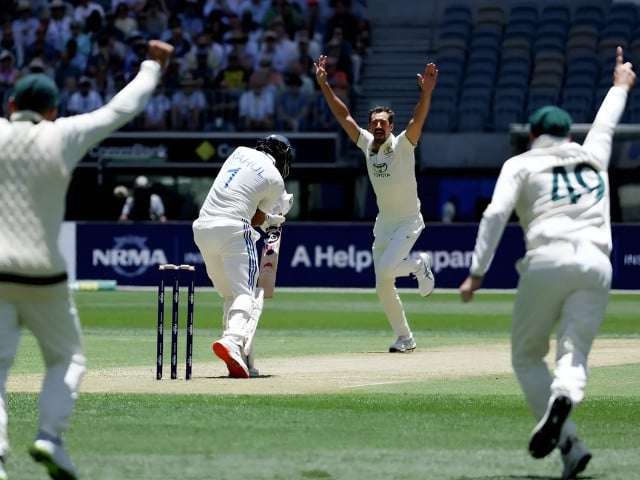Introduction
In a thrilling turn of events during the first Test between South Africa and Pakistan, the match saw significant shifts on the second day. South Africa moved closer to Pakistan’s first innings total, reducing the deficit to just 31 runs with five wickets remaining. Aiden Markram was the star of the day, inching closer to a century and playing a pivotal role in South Africa’s recovery after the early loss of a wicket. Pakistan’s bowlers struggled to make inroads, with the Centurion pitch offering little assistance.
Day Two Overview: South Africa Fights Back
After Pakistan’s dramatic batting collapse in the first innings, it was South Africa’s turn to dig in and show resilience. As day two unfolded, the hosts faced the challenge of chasing down Pakistan’s total with a series of strong performances. South Africa’s ability to hold steady, even after losing wickets, contrasted sharply with Pakistan’s earlier fragility.
The pitch, which had been somewhat challenging for the batsmen on the first day, began to flatten out by the second. Pakistan’s bowlers, particularly Naseem Shah and Mohammad Abbas, initially made the most of the early conditions. However, the pitch offered less assistance as the day progressed, and the bowlers failed to maintain the pressure consistently. Despite early movement from Naseem, Pakistan’s attack lacked the sharpness needed to trouble the South African batsmen.
Markram’s Half-Century: A Foundation for South Africa
Aiden Markram, leading the charge for South Africa, demonstrated composure and confidence throughout his innings. His partnership with Temba Bavuma was crucial in steadying the ship after an early wicket. Markram was quick to bring up his half-century, reaching the milestone in style with a couple of boundaries off Mohammad Abbas. At this point, he looked comfortable and in full control, offering little to Pakistan’s bowlers.
Bavuma, solid in defense, was unflappable against Naseem’s pace, although he did survive a close moment early on when a thick outside edge narrowly missed the slips. The two South African batsmen built an important partnership that kept the scoreboard ticking along at a steady pace.
Pakistan’s Early Struggles and Breakthroughs
Pakistan’s attack seemed off-color for much of the day. Khurram Shahzad, who had been relatively quiet in the first part of the session, wasn’t introduced into the attack until 90 minutes had passed. By that time, South Africa had already made significant inroads. When Aamer Jamal finally made the breakthrough, it was a moment of relief for Pakistan. He forced Temba Bavuma to edge a delivery outside off stump, sending it through to the wicketkeeper.
Despite this breakthrough, South Africa managed to maintain their composure. Unlike Pakistan’s collapse earlier in the match, the South Africans were determined to rebuild and did so effectively. David Bedingham joined Markram at the crease, and the two batsmen carried the momentum forward.
Bedingham and South Africa’s Resilience
David Bedingham’s arrival at the crease injected some much-needed confidence into South Africa’s innings. He played aggressively and with purpose, helping to accelerate the scoring rate. A successful lbw review seemed to give Bedingham an extra boost of confidence. His stroke play was bold and fluid, and he quickly settled into a rhythm alongside Markram.
However, Pakistan’s bowlers made an adjustment in their strategy. Naseem Shah, changing his length and testing Bedingham outside off, was eventually rewarded with a wicket. Bedingham, looking to drive on the back foot, edged a ball to first slip where Kamran Ghulam took a clean catch.
While the dismissal of Bedingham provided Pakistan with a glimmer of hope, South Africa remained in a strong position. Markram, still at the crease, was on the verge of reaching a century and was looking dangerous. With only five wickets remaining, South Africa’s prospects of surpassing Pakistan’s total were high.
Pakistan’s Hopes for a Fightback
Despite the loss of Bedingham, Pakistan’s bowlers could take some encouragement from the breakthrough. The dismissal of a dangerous batsman like Bedingham gave them a fresh opportunity to exert some pressure and try to halt South Africa’s progress.
At the same time, Pakistan knew that South Africa had set the stage for a challenging total. With Markram approaching his century, the key to Pakistan’s success would lie in breaking his partnership and dismissing the remaining South African batsmen. The hope for a fightback remained, but the onus was on Pakistan to strike quickly before South Africa could build a commanding lead.
Conclusion: An Exciting Contest Ahead
As the second day of the first Test came to a close, South Africa found themselves in a strong position, largely thanks to Aiden Markram’s gritty performance. The chase for Pakistan’s total continues, with South Africa needing just 31 more runs and five wickets in hand. Pakistan’s bowlers will need to regroup and find a way to break South Africa’s remaining partnerships to keep the game in balance.
Markram, inching closer to a century, is the key figure in this phase of the match. His determination and resilience, coupled with the steady partnerships he has forged, give South Africa a clear advantage. However, Pakistan will be hopeful that the dismissal of Bedingham could be the turning point they need to launch a comeback.
The match remains finely poised, with plenty of cricket still to be played. Both teams have shown their strengths and weaknesses, making it a contest worth watching until the very end.
FAQs
1. How many runs does South Africa need to overtake Pakistan’s first innings total?
South Africa is currently 31 runs behind Pakistan’s total with five wickets remaining.
2. Who has been the standout performer for South Africa in this match?
Aiden Markram has been the standout performer for South Africa, playing a vital role in their recovery with a half-century and heading toward a potential century.
3. How has Pakistan’s bowling attack fared in this match?
Pakistan’s bowlers, particularly Naseem Shah and Mohammad Abbas, struggled to maintain consistent pressure, although they did manage to make a breakthrough with the dismissal of Temba Bavuma.
4. What changes did Pakistan make to their bowling strategy?
Pakistan made adjustments to their bowling strategy by changing lengths and testing the South African batsmen outside off stump, especially with Naseem Shah, which resulted in the dismissal of David Bedingham.
5. Can Pakistan mount a comeback in this Test match?
While South Africa has a strong position, Pakistan still has an opportunity to make a comeback by targeting the remaining South African batsmen and capitalizing on any further mistakes
MUST READ
https://flarenews.pk/2024/12/27/dg-isprs-commitment-to-pakistans-interests/



